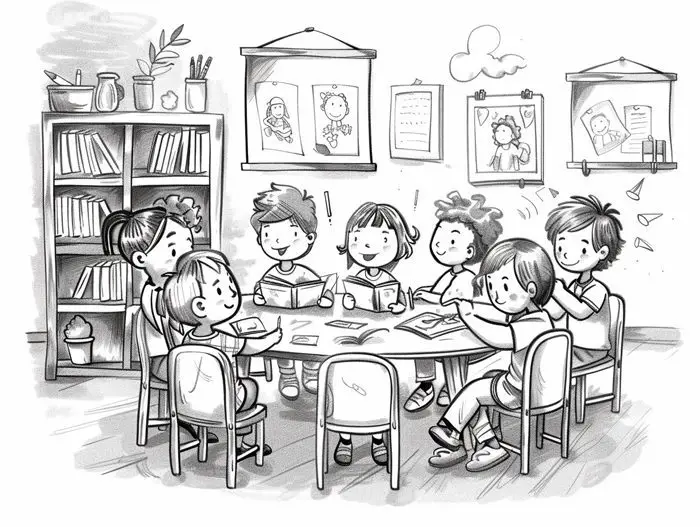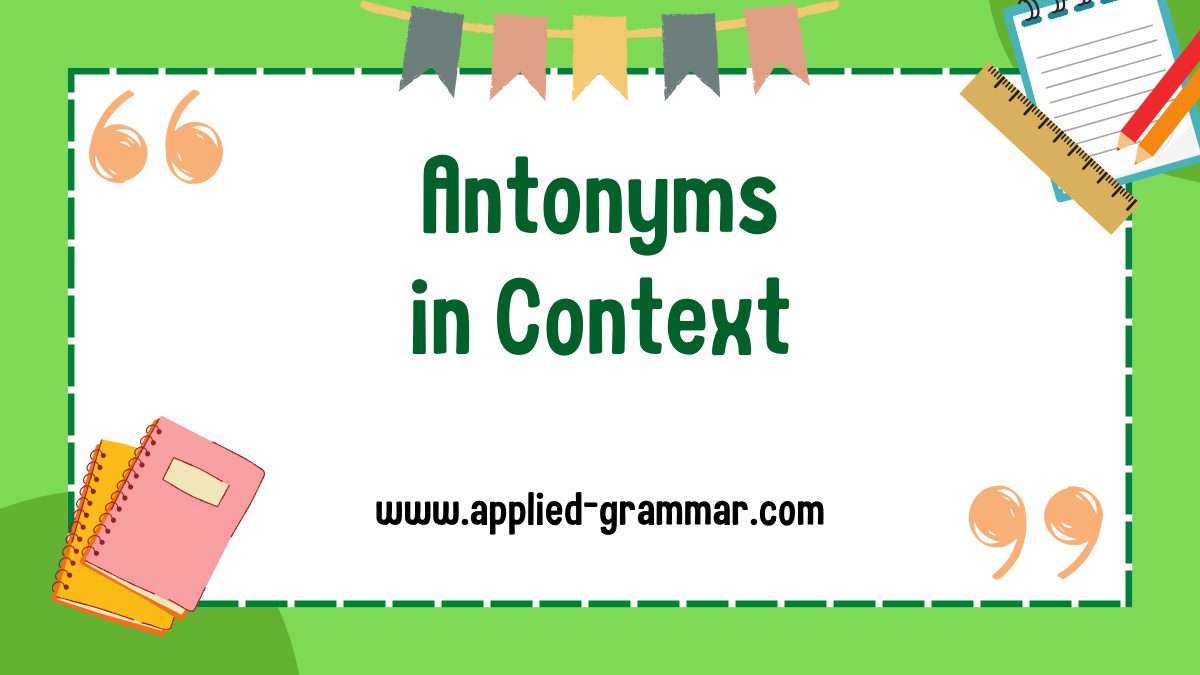Are you looking to add depth and nuance to your writing? Antonyms can be a powerful tool in conveying contrasting meanings and enhancing your sentences. But, it’s important to use them accurately and in the right context to avoid common pitfalls.
One common mistake is using inaccurate antonyms that don’t truly convey opposite meanings. To ensure accuracy, it’s crucial to consult a reliable source or dictionary. Also, while antonymy can enhance your writing, overusing antonyms can make your sentences sound forced or contrived. Striking a balance and using antonyms judiciously is key to maintaining readability and coherence.
Antonyms derive their meaning from the context in which they are used. Neglecting the overall context of your sentence can lead to confusion or ambiguity. Always make sure that the antonyms you choose align with the intended message and context of your writing. In this text, we will explore how antonyms in context can effectively convey meaning and enhance your comprehension of language and concepts.
Key Takeaways
- Antonyms are powerful tools in conveying contrasting meanings and enhancing sentences.
- Ensure accurate usage of antonyms by consulting reliable sources or dictionaries.
- Use antonyms judiciously to maintain readability and coherence in writing.
- Antonyms derive their meaning from the context in which they are used.
- Antonyms provide clarity, enhance understanding, avoid ambiguity, balance contrasts, and express nuance in communication.
- Antonyms can be used as a comparative tool, for emphasis and contrast, and in different types such as gradable, complementary, and relational.
- Understanding antonyms is crucial for expanding vocabulary, enhancing comprehension, expressing ideas with precision, and contextual awareness in language learning.
Why Antonyms Matter in Context

Antonyms, or words that have opposite meanings, play an important role in communication. By using antonyms in context, we can convey meaning effectively and enhance comprehension. Understanding the significance of antonyms can help you become a more skilled writer and reader. Here’s why antonyms matter in context:
Clarity and Precision
Antonyms provide a clear contrast and help us express ideas precisely. By using antonyms, we can highlight the differences between two concepts or create emphasis in our writing. For example, using the antonyms “success” and “failure” can instantly convey the different outcomes of a situation.
Enhanced Understanding
Antonyms help improve understanding by providing context and helping to define words. When encountering an unfamiliar word, if you can identify its antonym, you can gain insight into its meaning. By using antonyms strategically, you can make your writing more accessible and help your readers grasp complex concepts.
Avoiding Ambiguity
Choosing the appropriate antonym in a sentence can help avoid confusion or ambiguity. By using antonyms, you can provide clarity and ensure that your intended meaning is understood. For example, if you want to express the opposite of “love,” the antonym “hate” will make your message clear.
Balancing Contrasts
Contrasting ideas are essential in writing. Antonyms allow us to balance and juxtapose contrasting concepts, creating dynamic and engaging content. Using antonyms can make your writing more interesting and thought-provoking, capturing the attention of your audience.
Expressing Nuance
Antonyms provide an opportunity to express nuance and shades of meaning. By carefully selecting the right antonym, you can convey subtleties and add depth to your writing. This allows for a more nuanced and sophisticated expression of ideas.
To conclude, antonyms play a crucial role in communication by providing clarity, enhancing understanding, avoiding ambiguity, balancing contrasts, and expressing nuance. By using antonyms effectively in context, you can elevate your writing and engage your audience. So, keep in mind the power of antonyms and leverage them to convey meaning with precision and impact.
How Antonyms Convey Meaning
Antonyms play a crucial role in language and communication by providing clear contrasts, emphasizing differences, and enhancing the depth of our expression. Understanding how antonyms convey meaning can greatly enrich your writing and improve your ability to engage your audience. In this section, we will explore two key ways in which antonyms contribute to conveying meaning: as a comparative tool and for emphasis and contrast.

Antonyms as Comparative Tool
Antonyms provide a valuable comparative tool that allows us to highlight differences between objects, ideas, or qualities. By using antonyms, you can add precision and clarity to your writing, enabling your readers to grasp the intended meaning with ease. Consider the following example:
“The night was dark, but the day was bright.”
In this sentence, the antonyms “dark” and “bright” create a clear contrast, emphasizing the difference in lighting conditions between night and day. This comparison helps to convey a vivid image and enhances the overall understanding of the scene.
Antonyms for Emphasis and Contrast
Antonyms also serve as powerful tools for emphasizing and contrasting ideas. By using antonyms, you can draw attention to specific aspects of your writing and create a more impactful message. For instance:
“She is tall, while he is short.”
In this example, the antonyms “tall” and “short” highlight the disparity in height between two individuals. The contrasting nature of these antonyms adds emphasis and creates a vivid mental image, allowing the reader to easily visualize the scene and the characters involved.
Using antonyms for emphasis and contrast helps to bring your writing to life, making it more engaging and memorable for your audience. By strategically incorporating antonyms into your writing, you can effectively convey your intended meaning and capture your readers’ attention.
Summarizing, antonyms contribute to conveying meaning by serving as a comparative tool and by providing emphasis and contrast. By utilizing antonyms in your writing, you can add precision, clarity, and depth to your communication. Keep these strategies in mind as you harness the power of antonyms to elevate and engage your audience.
Types of Antonyms

Gradable Antonyms
Gradable antonyms represent a scale or continuum of meaning, allowing for varying degrees of intensity. These antonyms define words that are at opposite ends of a spectrum, with some gradation between the two extremes. For example, we have “hot” and “cold,” with “warm” between them. Other examples include “empty” and “full,” “high” and “low,” and “young” and “old.” Gradable antonyms add nuance and precision to our language, enabling us to express subtle differences in intensity or magnitude.
Examples of Gradable Antonyms:
- Big / Small
- Loud / Quiet
- Happy / Sad
- Brave / Cowardly
- Strong / Weak
Complementary Antonyms
Complementary antonyms operate on the idea of clear opposition, where each word has a defined opposite. For example, “on” and “off” are complementary antonyms. Something can’t be “a little bit on,” just as a dishwasher can’t be turned “sort of on.” Complementary antonyms exist independently and cannot be partially true. In contrast to converse antonyms, complementary antonyms can stand alone. For instance, a child cannot exist without its antonym parent, but a family can have a mother without a complementary antonym father.
Examples of Complementary Antonyms:
- On / Off
- Day / Night
- Yes / No
- Alive / Dead
- Full / Empty
Relational Antonyms
Relational antonyms are words that describe opposite relationships or positions. They rely on the context and the relationship between objects or entities. Examples of relational antonyms include “parent” and “child,” “above” and “below,” and “employer” and “employee.” These pairs of words directly contrast the relationship or position being described.
Examples of Relational Antonyms:
- Parent / Child
- Above / Below
- Employer / Employee
- Borrower / Lender
- Owner / Tenant
Understanding the different types of antonyms allows you to recognize and use opposites in your writing effectively. Gradable antonyms add depth and precision, while complementary antonyms provide clear opposition, and relational antonyms describe contrasting relationships or positions. By incorporating antonyms in your writing, you can enhance clarity, convey meaning, and engage your audience.
The Role of Antonyms in Language Learning
Language learning is a dynamic process that involves grasping the intricacies of word meanings, nuances, and context. One crucial aspect of language learning is understanding antonyms – words that convey the opposite meaning of other words. Antonyms play a significant role in expanding your vocabulary, enhancing comprehension, and expressing ideas with precision.

How do antonyms contribute to language learning?
- Vocabulary Expansion: Antonyms provide an effective way to expand your vocabulary. When you learn a new word, understanding its antonym helps you to grasp its meaning more holistically.
- Enhanced Comprehension: Antonyms offer clarity and depth to your understanding of word meanings. By knowing the opposite, you can better comprehend the intended message in a given context.
- Contextual Awareness: Antonyms help you to understand the subtle nuances that arise from using different words in various contexts. By recognizing antonyms, you can adapt your language usage accordingly to convey your message accurately.
- Expression of Ideas: Antonyms allow you to express contrasting ideas and positions more effectively. They provide a valuable tool for presenting balanced arguments and creating compelling rhetorical effects.
Examples of antonyms in language
To illustrate the significance of antonyms in language learning, here are a few examples:
- Hot vs. Cold: Understanding the antonym relationship between “hot” and “cold” enables you to communicate temperature-related concepts accurately.
- Good vs. Bad: Recognizing the antonyms “good” and “bad” is essential for accurately conveying positive and negative qualities.
- Fast vs. Slow: Knowledge of the antonyms “fast” and “slow” allows you to describe speed and pace with precision.
By incorporating diverse antonyms into your language learning journey, you can enhance your vocabulary, develop a deeper understanding of word meanings, and effectively express your ideas in a variety of contexts.
Remember, expanding your knowledge of antonyms requires practice and exposure to diverse texts and conversations. Embrace the power of antonyms in language learning, and you’ll unlock doors to improved comprehension and communication skills.
Conclusion
Using antonyms in your writing is essential for conveying meaning effectively. Antonyms play a crucial role in communication by providing clarity, enhancing understanding, avoiding ambiguity, balancing contrasts, and expressing nuance. They add depth, precision, and clear opposition to your writing.
By incorporating different types of antonyms such as gradable antonyms, complementary antonyms, and relational antonyms, you can add depth and complexity to your writing. These antonyms allow you to express contrasting ideas and create a more nuanced and balanced argument.
Plus to their importance in writing, antonyms also have a significant impact on language learning. They help expand your vocabulary, improve comprehension, develop contextual awareness, and enhance your ability to express ideas effectively.
Embracing the power of antonyms in language learning can greatly improve your comprehension and communication skills. So, make sure to incorporate antonyms in your writing to enhance clarity, precision, and overall impact. Remember, using antonyms accurately and in the right context is key to effectively conveying your intended meaning.
